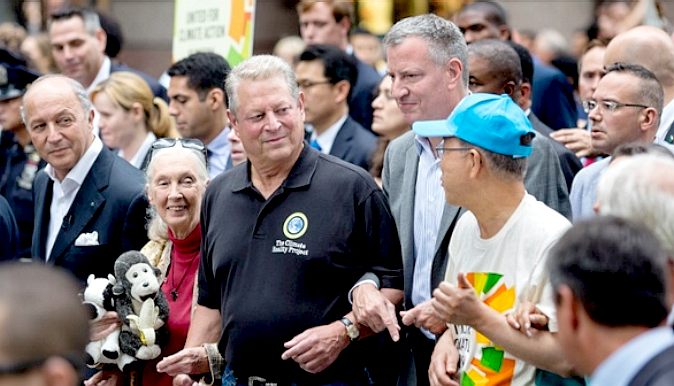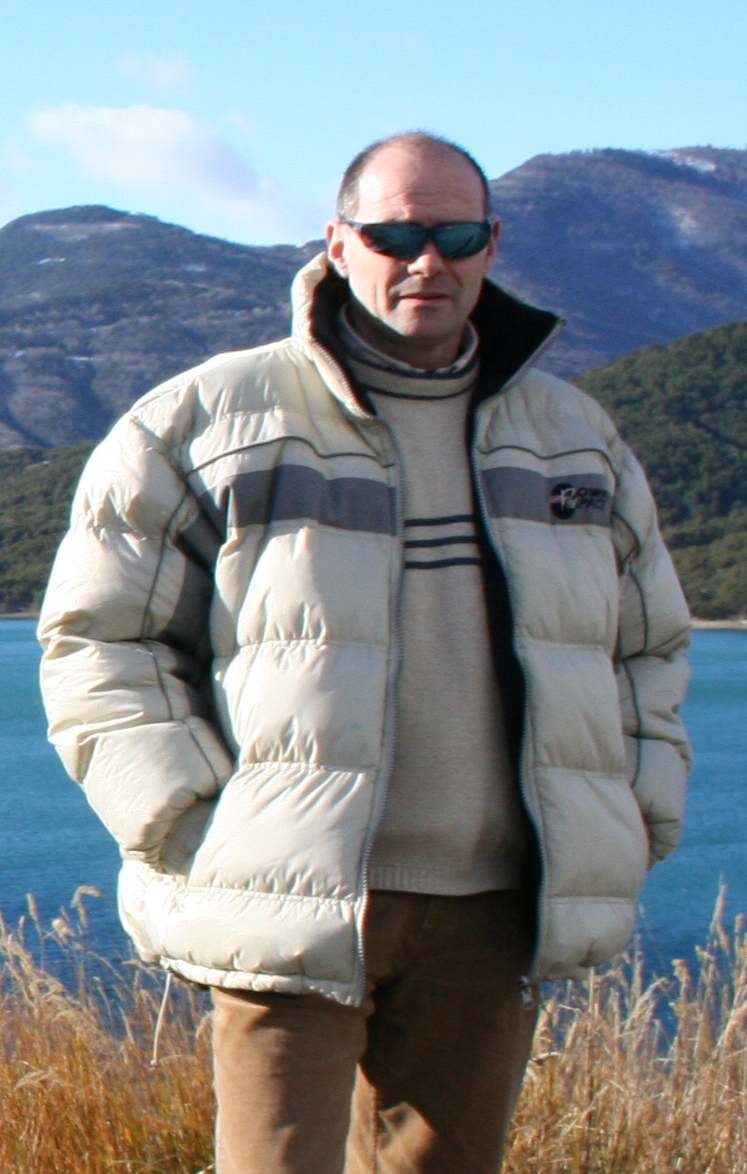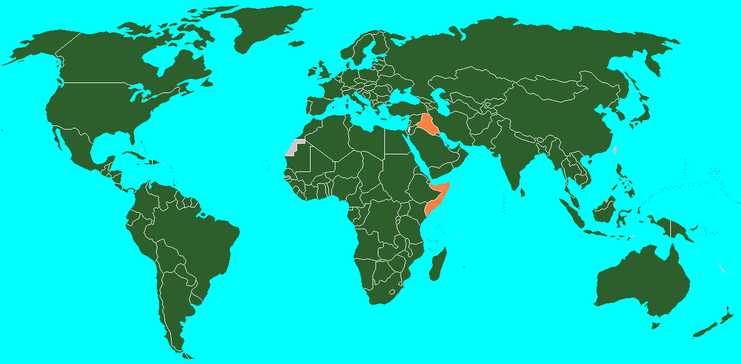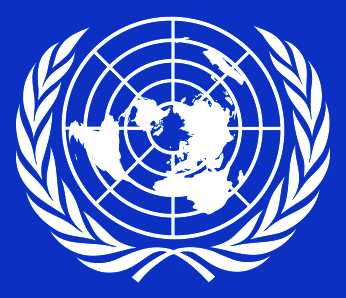|
CLIMATE CHANGE CONVENTION
|
|||||||||||||||||||||||||||||||||||||||||||||||||||||||
|
Renaissance Man: Climate Change protest New York - Laurent Fabius, Jane Goodall Al Gore, Bill de Blasio and Ban Ki Moon linked arms symbolic of the will of the people.
INTERNATIONAL AGREEMENTS TO REDUCE GREENHOUSE GASES
The United Nations Framework Convention on Climate Change (UNFCCC or FCCC) is an international environmental treaty produced at the United Nations Conference on Environment and Development (UNCED), informally known as the Earth Summit, held in Rio de Janeiro in 1992. The treaty is aimed at reducing emissions of greenhouse gas in order to combat global warming.
The treaty as originally framed set no mandatory limits on greenhouse gas emissions for individual nations and contained no enforcement provisions; it is therefore considered legally non-binding.
Rather, the treaty included provisions for updates (called "protocols") that would set mandatory emission limits. The principal update is the Kyoto Protocol, which has become much better known than the UNFCCC itself.
The FCCC was opened for signature on May 9, 1992. It entered into force on March 21, 1994. Its stated objective is "to achieve stabilization of greenhouse gas concentrations in the atmosphere at a low enough level to prevent dangerous anthropogenic interference with the climate system."
A national greenhouse gas inventory is is an accounting of greenhouse gas (GHG) emissions and removals that must be submitted by signatories of the United Nations Framework Convention on Climate Change.
Nelson says - "We must work harder for understanding and agreement, but we must also use all the technology at our disposal to overcome the most serious of issues that the human race has yet been faced with."
Annex I and Annex II Countries, and Developing Countries
Signatories to the UNFCCC are split into three groups:
Annex I countries agree to reduce their emissions (particularly carbon dioxide) to target levels below their 1990 emissions levels. If they cannot do so, they must buy emission credits or invest in conservation. Annex II countries, that have to provide financical resources for the developing countries, are a sub-group of the annex I countries consisting of the OECD members, without these that were with transition economy in 1992.
Developing countries have no immediate restrictions under the UNFCCC. This serves three purposes:
Developing countries may volunteer to become Annex I countries when they are sufficiently developed.
Developing countries are not expected to implement their commitments under the Convention unless developed countries supply enough funding and technology, and this has lower priority than economic and social development and dealing with poverty.
Some opponents of the Convention argue that the split between Annex I and developing countries is unfair, and that both developing countries and developed countries need to reduce their emissions. Some countries claim that their costs of following the Convention requirements will stress their economy. These were some of the reasons given by George W. Bush, President of the United States, for, as his predecessor did, not forwarding the signed Kyoto Protocol to the United States Senate.
Annex I parties
Annex I countries (industrialized countries): Australia, Austria, Belarus, Belgium, Bulgaria, Canada, Croatia, Czech Republic, Denmark, Estonia, Finland, France, Germany, Greece, Hungary, Iceland, Ireland, Italy, Japan, Latvia, Liechtenstein, Lithuania, Luxembourg, Monaco, Netherlands, New Zealand, Norway, Poland, Portugal, Romania, Russian Federation, Slovakia, Slovenia, Spain, Sweden, Switzerland, Turkey, Ukraine, United Kingdom, United States of America.
(40 countries and separately the European Union)
Annex II countries
Annex
II countries (developed countries which pay for costs of developing
countries)
(23 countries and separately the European Union; Turkey was removed from the annex II list in 2001 at its request to recognize its economy as a transition one [1].)
U.N. Framework Convention on Climate Change (UNFCCC)
The United Nations Framework Convention on Climate Change (UNFCCC) was opened for signature at the 1992 United Nations Conference on Environment and Development (UNCED) conference in Rio de Janeiro (known by its popular title, the Earth Summit). On June 12, 1992, 154 nations signed the UNFCCC, that upon ratification committed signatories' governments to a voluntary "non-binding aim" to reduce atmospheric concentrations of greenhouse gases with the goal of "preventing dangerous anthropogenic interference with Earth's climate system." These actions were aimed primarily at industrialized countries, with the intention of stabilizing their emissions of greenhouse gases at 1990 levels by the year 2000; and other responsibilities would be incumbent upon all UNFCCC parties. The parties agreed in general that they would recognize "common but differentiated responsibilities," with greater responsibility for reducing greenhouse gas emissions in the near term on the part of developed/industrialized countries, which were listed and identified in Annex I of the UNFCCC and thereafter referred to as "Annex I" countries.
On September 8, 1992, President Bush transmitted the UNFCCC for advice and consent of the U.S. Senate to ratification. The Foreign Relations Committee approved the treaty and reported it (Senate Exec. Rept. 102-55) October 1, 1992. The Senate consented to ratification on October 7, 1992, with a two-thirds majority vote. President Bush signed the instrument of ratification October 13, 1992, and deposited it with the U.N. Secretary General.
According to terms of the UNFCCC, having received over 50 countries' instruments of ratification, it entered into force March 24, 1994. Since the UNFCCC entered into force, the parties have been meeting annually in Conferences of the Parties (COP) to assess progress in dealing with climate change, and beginning in the mid-1990s, to negotiate the Kyoto Protocol to establish legally binding obligations for developed countries to reduce their greenhouse gas emissions.
COP-1, The Berlin Mandate
The UNFCCC Conference of Parties met for the first time in Berlin, Germany in the spring of 1995, and voiced concerns about the adequacy of countries' abilities to meet commitments under the Convention. These were expressed in a U.N. ministerial declaration known as the "Berlin Mandate", which established a 2-year Analytical and Assessment Phase (AAP), to negotiate a "comprehensive menu of actions" for countries to pick from and choose future options to address climate change which for them, individually, made the best economic and environmental sense. The Berlin Mandate exempted non-Annex I countries from additional binding obligations, in keeping with the principle of "common but differentiated responsibilities" established in the UNFCCC even though, collectively, the larger, newly industrializing countries were expected to be the world's largest emitters of greenhouse gas emissions 15 years hence.
COP-2, Geneva, Switzerland
The Second Conference of Parties to the UNFCCC (COP-2) met in July 1996 in Geneva, Switzerland. Its Ministerial Declaration was adopted July 18, 1996, and reflected a U.S. position statement presented by Timothy Wirth, former Under Secretary for Global Affairs for the U.S. State Department at that meeting, which
COP-3, The Kyoto Protocol on Climate Change
The Kyoto Protocol to the United Nations Framework Convention on Climate Change was adopted by COP-3, in December 1997 in Kyoto, Japan, after intensive negotiations. Most industrialized nations and some central European economies in transition (all defined as Annex B countries) agreed to legally binding reductions in greenhouse gas emissions of an average of 6 to 8% below 1990 levels between the years 2008-2012, defined as the first emissions budget period. The United States would be required to reduce its total emissions an average of 7% below 1990 levels, however neither the Clinton administration nor the Bush administration sent the protocol to Congress for ratification. The Bush administration explicitly rejected the protocol in 2001.
COP-4, Buenos Aires
COP-4 took place in Buenos Aires in November 1998. It had been expected that the remaining issues unresolved in Kyoto would be finalized at this meeting. However, the complexity and difficulty of finding agreement on these issues proved insurmountable, and instead the parties adopted a 2-year "Plan of Action" to advance efforts and to devise mechanisms for implementing the Kyoto Protocol, to be completed by 2000.
COP-5, Bonn, Germany
The 5th Conference of Parties to the U.N. Framework Convention on Climate Change met in Bonn, Germany, between October 25 and November 5, 1999. It was primarily a technical meeting, and did not reach major conclusions.
COP-6, The Hague, Netherlands
When COP-6 convened November 13-November 25, 2000, in The Hague, Netherlands, discussions evolved rapidly into a high-level negotiation over the major political issues. These included major controversy over the United States' proposal to allow credit for carbon "sinks" in forests and agricultural lands, satisfying a major proportion of the U.S. emissions reductions in this way; disagreements over consequences for non-compliance by countries that did not meet their emission reduction targets; and difficulties in resolving how developing countries could obtain financial assistance to deal with adverse effects of climate change and meet their obligations to plan for measuring and possibly reducing greenhouse gas emissions. In the final hours of COP-6, despite some compromises agreed between the United States and some EU countries, notably the United Kingdom, the EU countries as a whole, led by Denmark and Germany, rejected the compromise positions, and the talks in The Hague collapsed. Jan Pronk, the President of COP-6, suspended COP-6 without agreement, with the expectation that negotiations would later resume [2]. It was later announced that the COP-6 meetings (termed "COP-6 bis") would be resumed in Bonn, Germany, in the second half of July. The next regularly scheduled meeting of the parties to the UNFCCC - COP-7 - had been set for Marrakech, Morocco, in October-November, 2001.
COP-6 "bis," Bonn, Germany
When the COP-6 negotiations resumed July 16-27, 2001, in Bonn, Germany, little progress had been made on resolving the differences that had produced an impasse in The Hague. However, this meeting took place after President George W. Bush had become the U.S. President, and had rejected the Kyoto Protocol in March; as a result the United States delegation to this meeting declined to participate in the negotiations related to the Protocol, and chose to act as observers at that meeting. As the other parties negotiated the key issues, agreement was reached on most of the major political issues, to the surprise of most observers given the low level of expectations that preceded the meeting. The agreements included:
A number of operational details attendant upon these decisions remained to be negotiated and agreed upon, and these were the major issues of the COP-7 meeting that followed.
This could be the fate of humans and all life on earth if we do not act quickly enough to stop climate change - before it is too late. The technology exists for us to be able to drive zero carbon cars, operate zero carbon ships and build zero carbon houses.
COP-7, Marrakech, Morocco
At the COP-7 meeting in Marrakech, Morocco October 29-November 10, 2001, negotiators in effect completed the work of the Buenos Aires Plan of Action, finalizing most of the operational details and setting the stage for nations to ratify the Protocol.[3] [4] The completed package of decisions are known as the Marrakech Accords. The United States delegation continued to act as observers, declining to participate in active negotiations. Other parties continued to express their hope that the United States would re-engage in the process at some point, but indicated their intention to seek ratification of the requisite number of countries to bring the Protocol into force (55 countries representing 55% of developed country emissions of carbon dioxide in 1990). A target date for bringing the Protocol into force was put forward: the August-September 2002 World Summit on Sustainable Development (WSSD) to be held in Johannesburg, South Africa.
The main decisions at COP-7 included:
COP-8, New Delhi, IndiaOctober 23 – November 1, 2002
COP-9, Milan, Italy
December 1 – 12 2003
COP-10, Buenos Aires, Argentina
December 6 – 17, 2004
COP-11, Montreal, Canada
The United Nations Climate Change Convention (COP 11 or COP/MOP 1) was a global event which took place at the Palais des congrès de Montréal in Montreal, Quebec, Canada from November 28 to December 9, 2005.
The meeting, the 11th Conference of the Parties (COP) to the United Nations Framework Convention on Climate Change (UNFCCC), was also the first Meeting of the Parties (MOP) to the Kyoto Protocol since their initial meeting in Kyoto in 1997. It was therefore one of the largest intergovernmental conferences on climate change ever. The event marked the entry into force of the Kyoto Protocol.
Hosting more than 10,000 delegates, it was one of Canada's largest international events ever and the largest gathering in Montreal since Expo 67.
The Montreal Action Plan is an agreement hammered out at the end of the conference to "extend the life of the Kyoto Protocol beyond its 2012 expiration date and negotiate deeper cuts in greenhouse-gas emissions." [5]
See also COP 11 pages at the UNFCCC.
COP-12, Nairobi, Kenya
The second meeting of the Parties to the Kyoto Protocol (COP/MOP 2), in conjunction with the twelfth section of the Conference of the Parties to the Climate Change Convention (COP 12), was held in Nairobi, Kenya from 6 to 17 November 2006. At the meeting, the phrase climate tourists was coined to describe some delegates who attended "to see Africa, take snaps of the wildlife, the poor, dying African children and women".[7]
COP-13, Bali, Indonesia
COP-13 and MOP-3 will take place at Nusa Dua, in Bali, Indonesia, between December 3 and December 14, 2007. Negotiations on a successor to the Kyoto Protocol are expected to dominate the conference.
COP-15, Copenhagen, Denmark
The COP-15 will be held in Copenhagen, Denmark in 2009. According to Danish Minister for the Environment, Connie Hedegaard, the summit's primary focus will be to obtain an agreement about CO2 reductions after 2012 when the Kyoto-protocol expires.
What good is the UN if they don't do anything that the people of the world want?
CONTACTS
The secretariat of the United Nations Framework Convention on Climate Change is located in Bonn,
Germany, but they give no postal address on their website at present!
LINKS and REFERENCE
http://newsroom.unfccc.int/ The Framework Convention on Climate Change at Law-Ref.org — fully indexed and crosslinked with other documents
World leaders need constant support from the electorate if they are to put corrective policies in place. Help us to remind your local representative by supporting our high profile mission.
Carbon Tax | Climate Change | Global Warming | Waste Recycling
MORE ON AGENDA 21 MEMBERS OF PARLIAMENT A-Z HOUSE OF LORDS A-Z COUNCIL'S AGENDA 21
Evolution accelerated by man
ANIMALS AT RISK:
Good for you - good for the planet
|
|||||||||||||||||||||||||||||||||||||||||||||||||||||||
|
This website is Copyright © 1999 & 2019 Max Energy Limited, an environmental educational charity working hard for world peace. The names Solar Navigator™,Blueplanet Ecostar BE3™ and Utopia Tristar™ are trademarks. All other trademarks are hereby acknowledged.
|






